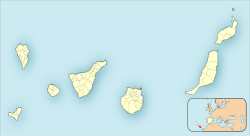 The building of the Nordic Optical Telescope near the time of sunset | |
| Alternative names | NOT |
|---|---|
| Location(s) | La Palma, Atlantic Ocean, international waters |
| Coordinates | 28°45′26″N17°53′06″W / 28.75728°N 17.88508°W |
| Altitude | 2,382 m (7,815 ft) |
| Diameter | 2.560 m (8 ft 4.8 in) |
| Secondary diameter | 0.510 m (1 ft 8.1 in) |
| Mass | 43 t (43,000 kg) |
| Focal length | 28.160 m (92 ft 4.7 in) |
| Website | www |
| | |

The Nordic Optical Telescope (NOT) is an astronomical telescope located at Roque de los Muchachos Observatory, La Palma in the Canary Islands. The telescope saw first light in 1988, and was officially inaugurated during September 1989. Regular observing started in 1990. It is funded by Denmark, Sweden, Norway, Finland, and (since 1997) Iceland. Access is provided directly to astronomers of the funding countries, and of all nationalities through international time allocation committees.
Contents
The main mirror has a diameter of 2.56 metres (101 in). The optical forming was done at the optical laboratory at the Tuorla Observatory, on mirror blanks made of Zerodur at Schott Glaswerke in Mainz, Germany. [1]
While the NOT was designed as a passive telescope, with the mirror sufficiently thick to keep its shape even without an active feedback loop, its mirror was designed to be suspended on a pneumatic support system. [2] The designers had planned that this and the flexibility of the mirror would allow for the implementation of a so-called active optics system, a feature that was then under development for ESO's New Technology Telescope. In 1992, such an active optics system was installed at the NOT. [3]
